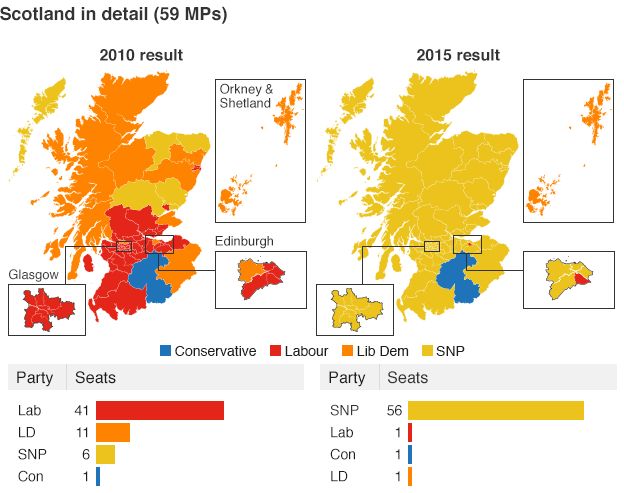A Guide to the 2017 General Election

Once more unto the polls, dear friends, once more.
Thanks to Theresa May’s call for a snap election we find ourselves going again back at the polling stations on June 8th to elect our representatives to the UK parliament, just two years after having done so previously. Time, then, for another of my impartial and non-partisan guides for first time voters or those who have not voted in some time and wish to know how to vote. As with my other voting guides, it will not be the place for this article to lobby for any particular vote. I’ll leave that to other blogs (such as, but not limited to, Scot Goes Pop, Wings Over Scotland and Wilderness of Peace) and to other articles.
Background
Whilst this is a UK wide election, the focus here will be on Scotland as that’s where I am and where I know best. It has been a time of great change in this country over the past decade or so, particularly in the aftermath of the 2014 Scottish Independence Referendum which saw a great divide in the landscape of the party politics of Scotland and a substantial surge in support for the pro-independence parties. The swing from the 2010 results to the 2015 results were dramatic enough to have carved a place forever in the history books and to have shocked many who were trying to predict the results ahead of time.

Since then, the rise of the Conservative and Unionist vote in Scotland, largely gained via that party’s cannibalisation of their former allies, Labour and the Lib Dems, has been the talk of the political water fountains. With the SNP sitting about as high as they possibly can in the rankings, most are asking how far their support will or will not erode and who will pick up any seats they may give away.
First: Register To Vote
This is the most important thing. If you are not registered to vote, you cannot vote. There is no “on the day” registration in Scotland and the deadline for the Council elections is 23:59 on May 22nd. If you are registered, you are likely to have received a polling card by now telling you where to vote. If you haven’t or if you know that you are not registered, then information on how to do so is here. Even with the relatively high turnouts seen in Scotland lately, it’s still often the case that more people do not vote than vote for the winning candidate in a seat. Get out and have your say.
Unfortunately, unlike the Scottish Parliamentary elections, the EU elections and the Scottish local elections, this vote is not open to 16 and 17 year olds nor to non-UK, EU citizens. Westminster is yet to catch up with the opening of the electoral franchise to these groups. If you find yourself in this situation the only thing I can suggest is that you lobby your friends and family who can vote to consider your needs along with their own and to continue to demand that things change in future elections.
How To Vote
Of the various election methods used in Scotland’s various elections, the one used in the General Election is both the easiest to explain how to fill out a ballot and the easiest to count and come to a result. For this election, Scotland is split into 59 constituencies as shown below.

In each of these constituencies several candidates will be vying for your vote. Despite the attention given to the political parties both in the media and in practice within government, technically you will not be voting for a party on your ballot sheet. You will be voting for a person to represent your constituency in the House of Commons and that person may or may not be a member of a party.
When you go to cast your vote, either at the polling station or via a postal vote, you will be presented with a ballot paper which looks something like the one below.

The candidates will be shown in alphabetical order according to surname and below their name will be shown their registered address and either the name of the party to which their belong (if any) or a slogan chosen by the party which represents something about them. The party’s logo may be shown to the right.
You may cast your vote by placing an X in the box beside your preferred candidate. Do not make any other mark on the paper and do not rank candidates in preference order as you may have done in the council elections as this will invalidate your vote.
Once done, put your ballot in the box and you’re done.
Counting the Votes
Once the polls are closed and the ballot boxes unsealed, it’s time to count the votes and decide who wins each seat.
The General Election is counted using the First Past The Post system, or FPTP. This system has the advantage of being very easy to count and always decides a single winner who will represent that seat.
In this system, the ballots are simply piled according to the X’s and whomever gains the most, even by a single vote, wins. There is no need to win a majority of votes (that is, over 50% of all votes cast) or anything like that. This does lead to the inherent unfairness of FPTP as one can easily see that in a race between, say, four nearly evenly matched candidates, the winner will be the one who receives just slightly over one quarter of all votes cast. In fact, Alasdair McDonnell of the SDLP did precisely this in 2015 winning the seat against six other candidates in Belfast South with a total of 24.5% of votes cast and currently holds the record for the lowest winning percentage of votes in a UK General Election.
This allocation of seats means that parties can win a large number of seats based on a relatively small percentage of the overall vote. Since WWII, there hasn’t been a single UK general election where the winning party has received more than 50% of the overall popular vote. When it comes to forming a government, the party with the most seats generally has the first chance to try to do so and, with only a few exceptions, it is generally the case in the UK that the winning party is able to form a majority government and rule alone. The previous Conservative government had a majority government despite only receiving 36.1% of the overall UK vote.
The limits of FPTP also mean that parties which have small but concentrated votes, such as the Lib Dems and the Greens of England and Wales, can receive seats by winning those individual constituencies whereas parties like UKIP can receive a broad level of support across many constituencies without winning any single one of them.
But, for worse or better, that’s the system we’ve got at the moment. I hope this guide helps folk understand it and helps you cast your vote on June 8th. If you haven’t voted before or were planning to not vote, I hope you turn out and have your say.

My tip for next election, as it’s too late for this one, is to get a postal vote. It makes the process a lot simpler and you won’t miss out if on holiday, working away etc.
I voted Green today in my own safe Tory southern constituency. A protest vote if ever there was one.
I particularly agreed with the English and Welsh Greens commitment to PR, making the House of Lords an elected body and allowing a popular vote on the Brexit agreement. Didn’t see any mention of Scotland.
Hope the pro-indy (i.e. SNP) vote holds up well in Scotland. The Greens in Scotland can’t win any seats due to FPTP and I’m glad they’ve only entered candidates in 3 seats. We need to work together to achieve independence.
LikeLike
The deadline for applying for a postal vote is 5pm on May 23rd. You must already be registered to vote before you apply for a postal vote. Details here: https://www.yourvotematters.co.uk/how-do-i-vote/voting-by-post
LikeLike
Pingback: My Democratic Dilemma | The Common Green
Pingback: The State of This (Union) | The Common Green
What a fantastic post! Thanks a lot for sharing.
LikeLike
Pingback: Senatus Populusque Caledoniae | The Common Green
Pingback: 2017 at The Common Green | The Common Green
Pingback: As Many As Are Agreed | The Common Green
Pingback: How Scotland Votes: A Guide to the European Elections | The Common Green
Pingback: How Scotland Votes: A Guide to the 2019 UK General Election | The Common Green
Pingback: How Scotland Votes: A Guide to the 2021 Scottish Election | The Common Green
Pingback: How Scotland Votes: A Guide to the 2022 Scottish Local Authority Elections | The Common Green